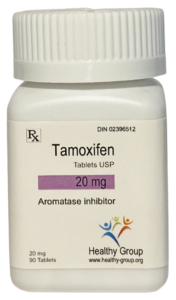Tamoxifen Citrate Tablet, USP
DIN 02396512
20 mg
90 tablets, Square container

DESCRIPTION Tamoxifen, also known under the name of Nolvadex, is used to treat and to prevent some types of breast cancer. It is prescribed to women who are most likely to develop breast cancer and to women with DCIS (after surgery and radiation). It blocks the female hormone called estrogen to prevent the growth of tumors that are triggered by it, a hormone related to breast cancer.
For steroid users, Tamoxifen reduces the amount of circulating estrogen and prevents gynecomastia. The gynecomastia, for a steroid user, can develop breast tissue enlargement, which is commonly a consequence of some steroid use, but in some instances, it is estrogen mediated. Tamoxifen may be used for estrogen mediated gynecomastia, antagonizing estrogen in breast tissues.
COMPOSITION Each tablet contains: Medicinal ingredients. Tamoxifen citrate 20 mg Non-medicinal ingredients. Microcrystalline cellulose, calcium carbonate, steric acid, magnesium stearate.
CLINICAL PHARMACOLOGY A nonsteroidal agent with antiestrogenic properties. Tamoxifen itself is a prodrug, having relatively little affinity for its target protein, the estrogen receptor. It is metabolized in the liver by the cytochrome P450 isoform CYP2D6 and CYP3A4 into active metabolites such as 4-hydroxytamoxifen (afimoxifene) and N-desmethyl-4-hydroxytamoxifen (endoxifen), which have 30-100 times more affinity with the estrogen receptor than tamoxifen itself. These active metabolites compete with estrogen in the body for binding to the estrogen receptor. In breast tissues, 4-hydroxytamoxifen acts as an estrogen receptor antagonist so that transcription of estrogen-responsive genes is inhibited. 4-hydroxytamoxifen binds to estrogen receptors (ER), the ER/tamoxifen complex recruits other proteins known as co-repressors and then binds to DNA to modulate gene expression.
ABSORPTION AND DISTRIBUTION Following a single oral dose of 20 mg tamoxifen, an average peak plasma concentration of 40 ng/mL (range 35 to 45 ng/mL) occurred approximately 5 hours after dosing. The decline in plasma concentration of tamoxifen is biphasic with a terminal elimination half-life of about 5 to 7 days. The average peak plasma concentration of N-desmethyl tamoxifen is 15 ng/mL (range 10 to 20 ng/mL). Chronic administration of 10 mg tamoxifen given twice daily for 3 months to patients results in average steady-state plasma concentrations of 120 ng/mL (range 67-183 ng/mL) for tamoxifen and 336 ng/mL (range 148-654 ng/mL) for N-desmethyl tamoxifen. The average steady-state plasma concentrations of tamoxifen and N-desmethyl tamoxifen after administration of 20 mg tamoxifen once daily for 3 months are 122 ng/mL (range 71-183 ng/mL) and 353 ng/mL (range 152-706 ng/mL), respectively. After initiation of the therapy, a steady state of concentrations of tamoxifen may be achieved in about 4 weeks and a steady-state of concentration for N-desmethyl tamoxifen may be achieved in about 8 weeks, suggesting a half-life of approximately 14 days for this metabolite. In a steady-state, crossover study of 10 mg tamoxifen tablets given twice a day vs. a 20 mg tamoxifen tablet given once daily, the 20 mg tamoxifen tablet was bioequivalent to the 10 mg tamoxifen tablets.
METABOLISM Tamoxifen is extensively metabolized after oral administration. N-desmethyl tamoxifen is the major metabolite found in patients’ plasma. The biological activity of N-desmethyl tamoxifen appears to be similar to that of tamoxifen. 4-Hydroxytamoxifen and a side chain primary alcohol derivative of tamoxifen have been identified as minor metabolites in plasma. Tamoxifen is a substrate of cytochrome P-450 3A, 2C9 and 2D6, and an inhibitor of P-glycoprotein.
INDICATIONS AND USAGE Metastatic Breast Cancer:Tamoxifen is effective in the treatment of metastatic breast cancer to women and men. In premenopausal women with metastatic breast cancer, Tamoxifen is an alternative to oophorectomy or to ovarian irradiation. Available evidence indicates that patients whose tumors are estrogen receptor positive are more likely to benefit from Tamoxifen therapy.
ADVERSE REACTIONS Most common side effects may include hot flashes, vaginal dryness and discharge or irritation; nausea, leg cramps, itching, fast heartbeat, headache. A loss of sexual ability/interest may occur in men. Other less common side effects may also occur.
STORAGE INSTRUCTIONS Store tamoxifen at room temperature, between 15-30 degrees Celsius
(59° to 86° F),in a tightly closed, light-resistant container. Keep out of reach of children.
